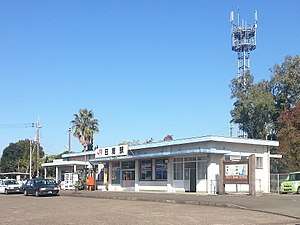Nichinan Station
Nichinan Station (日南駅, Nichinan-eki) is a train station in Nichinan, Miyazaki Prefecture, Japan. It is operated by of JR Kyushu and is on the Nichinan Line.[1][2]
Nichinan Station 日南駅 | |
|---|---|
 Nichinan Station in 2013 | |
| Location | Japan |
| Coordinates | 31°36′10″N 131°22′52″E |
| Operated by | |
| Line(s) | ■ Nichinan Line |
| Distance | 43.8 km from Minami-Miyazaki |
| Platforms | 1 side platform |
| Tracks | 1 |
| Construction | |
| Structure type | At grade |
| Parking | Available |
| Bicycle facilities | Bike shed |
| Other information | |
| Status | Kan'i itaku station |
| Website | Official website |
| History | |
| Opened | 28 October 1941 |
| Previous names | Agata (until 1 January 1952) |
| Traffic | |
| Passengers (FY2016) | 256 daily |
| Location | |
 Nichinan Station Location within Japan | |
Lines
The station is served by the Nichinan Line and is located 43.8 km from the starting point of the line at Minami-Miyazaki.[3]
Layout
The station consists of a side platform serving a single track at grade. A disused platform stands to the east of the track. The station building is a modern steel frame structure which houses a staffed ticket window and a waiting area. A bike shed and parking are available at the station forecourt.[2][3]
JR Kyushu had planned to cease staffing the station. To maintain service to residents, the Nichinan City authorities took over the management of the ticket window as a kan'i itaku agent on 1 April 2015.[4][5]
History
Japanese Government Railways (JGR) had opened the Shibushi Line from Nishi-Miyakonojō to Sueyoshi (now closed) in 1923. By 1925, the line had been extended eastwards to the east coast of Kyushu at Shibushi. The line was then extended northwards in phases, reaching Aburatsu by 1937. The track was extended further north with Kitagō opening as the northern terminus on 28 October 1941. Nichinan, at that time named Agata (吾田), was one of several intermediate stations opened on the same day on the new track. The station was renamed Nichinan on 1 January 1952. The route was designated the Nichinan Line on 8 May 1963. With the privatization of JNR on 1 April 1987, the station came under the control of JR Kyushu.[6][7][8]
Passenger statistics
In fiscal 2016, the station was used by an average of 256 passengers (boarding only) per day.[9]
See also
References
- "JR Kyushu Route Map" (PDF). JR Kyushu. Retrieved 23 February 2018.
- "日南" [Nichinan]. hacchi-no-he.net. Retrieved 10 May 2018.
- Kawashima, Ryōzō (2013). 図説: 日本の鉄道 四国・九州ライン 全線・全駅・全配線・第7巻 宮崎・鹿児島・沖縄エリア [Japan Railways Illustrated. Shikoku and Kyushu. All lines, all stations, all track layouts. Volume 7 Miyazaki Kagoshima Okinawa Area] (in Japanese). Kodansha. pp. 55, 96. ISBN 9784062951661.
- "市町運営で無人化防ぐ JR日南と都農駅" [City to take over management to avert unstaffing of JR Nichinan and Tsuno stations]. Miyazaki Mainichi Shimbun website. 31 March 2015. Retrieved 10 May 2018.
- "日南駅" [Nichinan Station]. jr-mars.dyndns.org. Retrieved 10 May 2018. See images of tickets sold.
- Ishino, Tetsu; et al., eds. (1998). 停車場変遷大事典 国鉄・JR編 [Station Transition Directory - JNR/JR] (in Japanese). I. Tokyo: JTB Corporation. pp. 232–3. ISBN 4533029809.
- Ishino, Tetsu; et al., eds. (1998). 停車場変遷大事典 国鉄・JR編 [Station Transition Directory - JNR/JR] (in Japanese). II. Tokyo: JTB Corporation. p. 775. ISBN 4533029809.
- Imao, Keisuke (2009). 日本鉄道旅行地図帳 12号 九州 沖縄―全線・全駅・全廃線 [Japan Rail Travel Atlas No. 12 Kyushu Okinawa - all lines, all stations and disused lines] (in Japanese). Mook. pp. 21, 62–3. ISBN 9784107900302.
- "宮崎県統計年鑑 鉄道輸送実績(1日平均)" [Miyazaki Prefecture Statistics Yearbook Railway Transportation Record (daily average)]. Miyazaki Prefectural Government website. Archived from the original on 7 May 2018. Retrieved 6 May 2018. See the table for 平成28年度 [fiscal 2016].
| Wikimedia Commons has media related to Nichinan Station. |